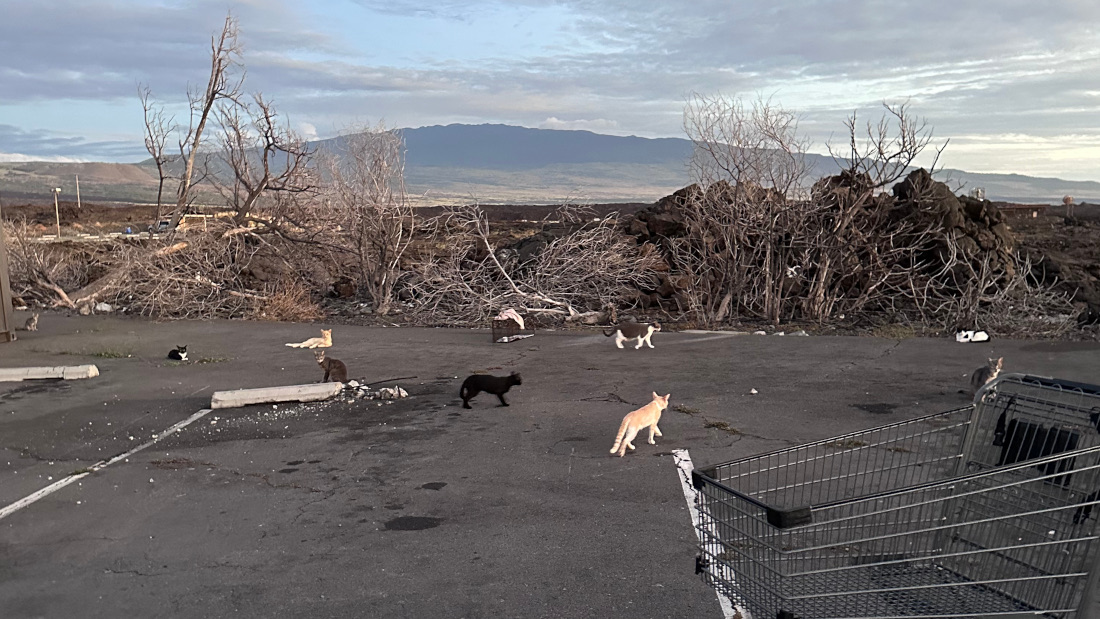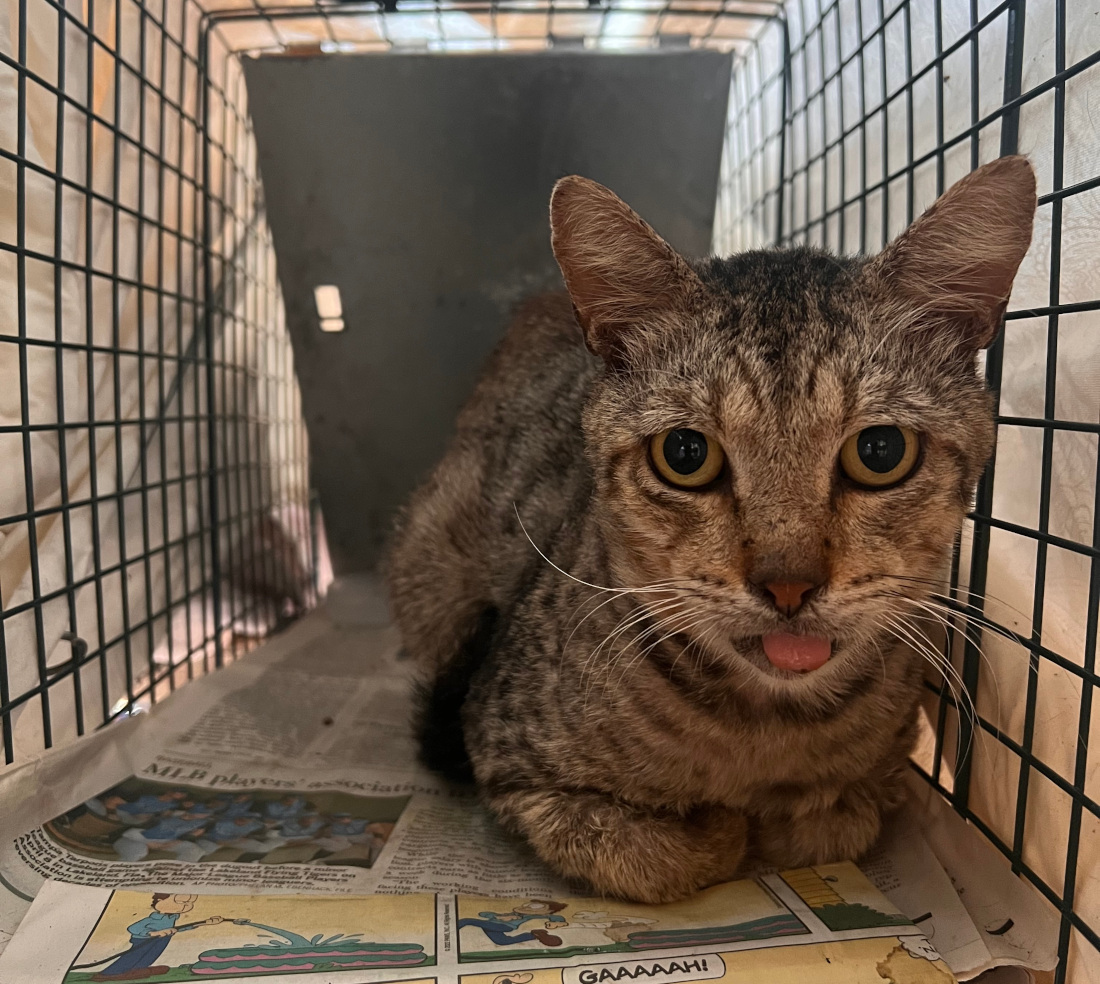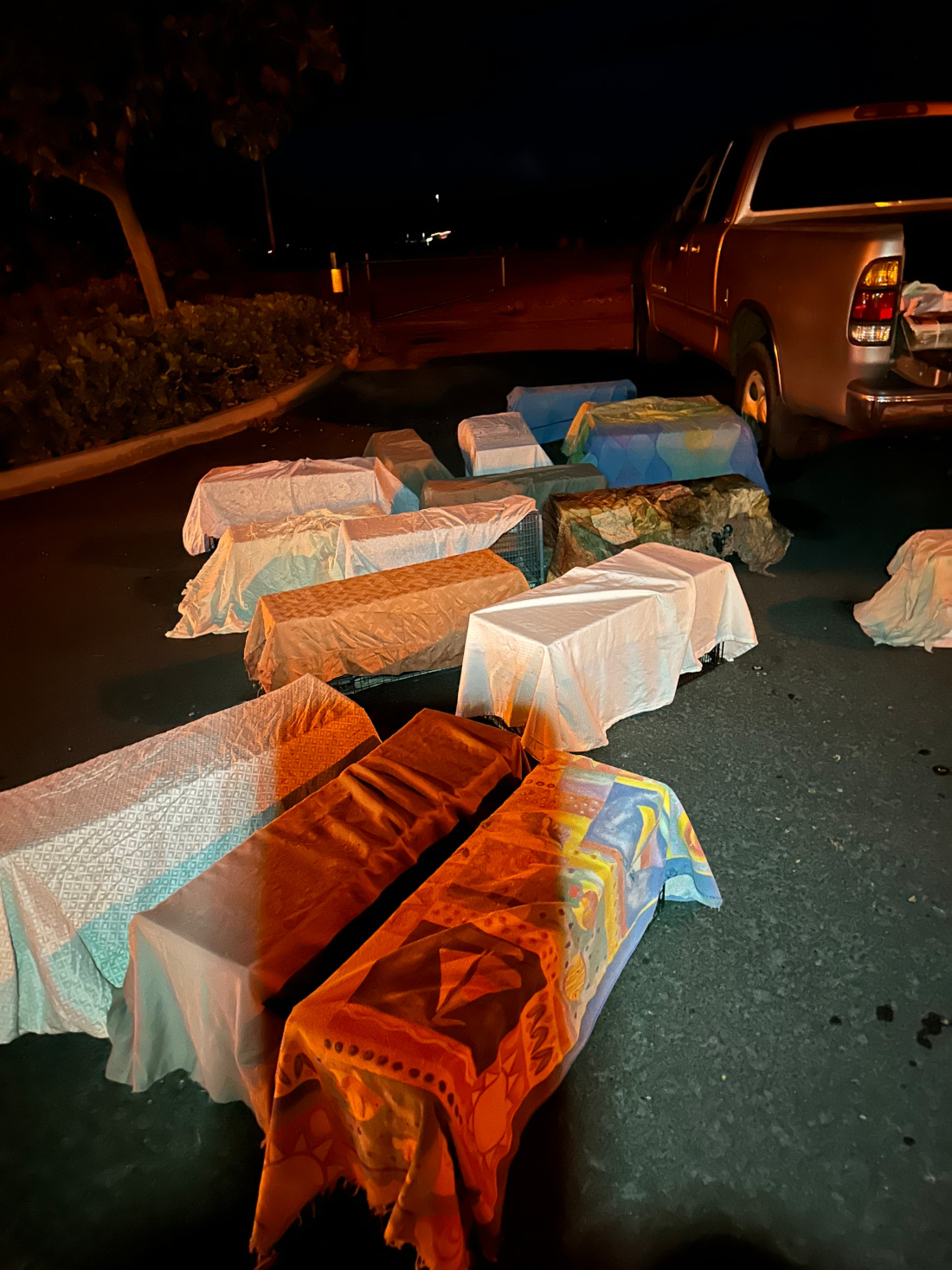This story appears in the above BIVN Update. The video will jump to the associated story when played. (A synthesized voice was utilized in the narration for this story)
(BIVN) – An effort to catch and relocate a large number of feral cats from a parking lot in the Waikōloa Resort area is underway, with 64 cats already reported captured, spayed/neutered, and rehomed.
The Hawaiʻi Department of Land and Natural Resources recently ordered the removal the cat feeding stations from the parking lot of Queens’ Marketplace, due to the impact the stations have on the endangered nēnē.
From a Kuleana Communications news release on behalf of Aloha Animal Oasis and Hawai‘i Animal Kuleana Alliance:
64 cats and kittens were caught at Queens’ Marketplace at the Waikōloa Resort over the weekend of May 19-22. After their capture, the cats were spayed/neutered, vaccinated, and microchipped before being delivered to their new homes across Hawai‘i Island. The relocation project was initiated and carried out by local animal rescue organizations Aloha Animal Oasis (AAO) and Hawai‘i Animal Kuleana Alliance (HAKA).
The relocation project was created in response to the Hawai‘i Department of Land and Natural Resources’ (DLNR) prohibition of cat feeding in the area due to the increased presence of nēnē. Volunteers and an area animal rescue had regularly fed and watered the cats around Queens’ Marketplace, owned by Alexander & Baldwin, for many years as the cat population grew. The numbers of nēnē began to increase throughout 2022, with the birds becoming noticeably more interested in the cat feeding stations in the months leading up to the ban, which was initiated on April 21, 2023.
The nēnē is Hawai‘i’s endemic goose that is recognized as endangered by the state. Because of this status, DLNR could not allow the continued feeding of the cats and nēnē. Additional information provided by DLNR through flyering in the Waikōloa area elaborated on the reasoning for not allowing the feeding, including: cat food is not a natural diet item for nēnē; cat feeding affects the natural behaviors of nēnē, bringing them into close contact with people and roads, exposing them to dangers from vehicles, dogs, feral cats, and mongoose; feeding ‘habituates’ nēnē to humans, leading to separation from their natural environment and further reliance on feeding stations.
DLNR offered relocation as the only real option for the cats, spurring local animal advocate Melanie Thomas to engage with the animal rescue organizations and key stakeholders in finding a solution. Alexander & Baldwin, DLNR, Hawaiʻi County Animal Control Director Regina Serrano, and Senator H.M. Tim Richards, III, played vital roles in making the project happen.
After an online campaign to solicit adopters, the team found 17 homes for 64 cats and kittens, stretching from Ocean View to Honoka‘a, Hawaiian Paradise Park to Captain Cook. Cat and kitten adopters were provided large outdoor kennels (on loan), food, litter, and other supplies to get the cats off to a good start in their new homes. All cats were spayed or neutered at a private clinic by partner organization PetFix Spay & Neuter. They were also tested for FIV/FeLV, vaccinated, and microchipped during the clinic.
“Although numbers are very difficult to determine, we estimate around 100 cats remain in the Queens’ Marketplace area. Our first trapping weekend was very successful, and we are overjoyed that these 64 kitties will be finding their forever homes in safe places where they can be lovingly cared for,” said John Hopf, President of Aloha Animal Oasis. “We could’ve easily trapped more, but were limited by the amount of homes that we were able to secure for the cats.”
This weekend’s relocation project is the first of several trapping and relocating events the organizations anticipate hosting. AAO and HAKA are still looking for adopters, volunteers, and donors to assist with future relocation projects that will likely stretch throughout the summer.
“Today, I commend the remarkable efforts of AAO, HAKA, and Melanie Thomas in balancing the needs of our feline friends while protecting our native species. I extend sincere gratitude to the compassionate veterinarian and those who adopted cats,” said Sen. Tim Richards. “I humbly ask our community to encourage 100 households to adopt the remaining cats at Waikōloa, benefiting both the cats and our native species. (One of my own cats is from the Waikōloa area!) By opening our hearts and homes, we can make a profound impact on their lives and ensure balance in our beautiful island’s ecosystem.”
Though this weekend was very successful, it barely makes a dent when it comes to the overall massive challenge of Hawai‘i Island’s community cat issue.
“Hawai‘i Island has a tremendous problem with pet overpopulation. Taking care of our pets by spaying/neutering, microchipping, and safely containing them is the humane way that we, as a lāhui, are going to make Hawai‘i Island safe for both our native species and our pets,” explained Syndi Halualani-Texeira, Executive Director of Hawai‘i Animal Kuleana Alliance.
“To make that happen, however, we have some fundamental issues that need to be addressed by our policymakers and stakeholders; our Island lacks the necessary spay/neuter and microchip services to meet the demand of pet owners and rescue organizations. HAKA is proud to continue its work with these and other stakeholders to help find solutions that work for everyone.”
The news release offers more information about this effort on the Hawaii Animal Kuleana Alliance website.




by Big Island Video News11:29 pm
on at
STORY SUMMARY
WAIKOLOA, Hawaiʻi - Local animal rescue organizations initiated the relocation project following the DLNR mandate putting an end to feeding the cats.